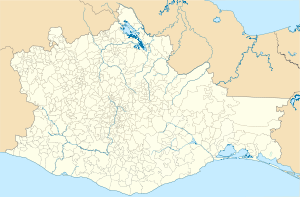Santo Domingo Yanhuitlán
| Santo Domingo Yanhuitlán | ||
|---|---|---|
|
Coordinates: 17 ° 32 ′ N , 97 ° 21 ′ W Santo Domingo Yanhuitlán on the map of Oaxaca
|
||
| Basic data | ||
| Country | Mexico | |
| State | Oaxaca | |
| Municipio | Santo Domingo Yanhuitlán | |
| Residents | 1002 (2010) | |
| Detailed data | ||
| height | 2037 m | |
| Santo Domingo Yanhuitlán - former Dominican monastery | ||
| Santo Domingo Yanhuitlán - Monastery Church, north side | ||
Santo Domingo Yanhuitlán is a place with about 1,000 inhabitants and the administrative seat of the municipality of the same name ( municipio ) with a total of about 1,800 inhabitants in the northwest of the state of Oaxaca in Mexico .
Location and climate
The place Santo Domingo Yanhuitlán is located in the Mixteca Alta directly on the connecting road N190 ( Panamericana ) between Mexico City and Oaxaca de Juárez approx. 92 km (driving distance) northwest of the city of Oaxaca at an altitude of approx. 2130 m ; The largest city in the vicinity is Asunción Nochixtlán, about 16 km southeast . The climate is dry and warm; the overall rather sparse rain (approx. 530 mm / year) falls mainly during the summer half-year.
Population development
| year | 2000 | 2005 | 2010 |
| Residents | 839 | 831 | 1.002 |
The local residents, some of whom have immigrated from the surrounding area, usually speak Mixtec or Nahuatl dialects.
economy
The people of the region still live largely self-sufficient from the yields of their fields (corn, wheat) and gardens (potatoes, beans, tomatoes, chilli, etc.). Cattle breeding is only practiced to a limited extent (chickens, turkeys). Due to its location, the place is suitable as a resting place near the main road.
history
Already in pre-Hispanic times Yanhuitlan was an important economic and trade center of the Mixtec -Indianer. On the site of the Dominican monastery there was probably a sanctuary built mainly from adobe bricks and wood. The Indians living here resisted both the Aztec and Spanish occupations. In the 16th century, the Dominican order built the largest and highest church in America up to that point on the heaped substructure of the Indian temple.
Attractions
- The former Santo Domingo monastery church was started around 1540 and probably completed around 1575; it makes an overall European impression, but it can be assumed that Mixtec stonecutters were also involved in the construction. While the portal zone shows clear Renaissance forms , the lower floors of the two towers are completely unadorned; Like some stepped buttresses , they primarily serve to stabilize the structure in the event of an earthquake . The west portal of the church, accompanied by a capilla abierta , was only opened on feast days; another portal is on the north side. The very high tracery windows could be understood as an indication that the politico-military situation in Central America at that time was still precarious, so that one wanted to arm oneself against feared attacks by the Indians. The four bays of the nave are a good 16 m high and are spanned by star-shaped rib vaults with a continuous crown rib and cross ribs. Interestingly, the yoke in front of the semicircular apse is not accentuated by a dome or in any other way, as was customary later ; the apse itself has a cassette- shaped rib vault. The polygonal broken main altar with numerous figure niches and paintings and the side altars are all works of the 17th and 18th centuries. The organ dates from around 1700; Like other parts of the church, it was restored at the end of the 20th and the beginning of the 21st century.
- The adjoining monastery has been partially converted into a museum.
- An aqueduct supplied the place and the monastery with fresh water.
Others
- Decorative plate
A golden decorative plate from Yanhuitlán with arrows and turquoise inlays is in the collection of the National Museum of Anthropology in Mexico City .
- Codex
An extensive codex made of bound paper, in which the history of the Mixtecs in the years 1532 to 1556 and various legal relationships between the Mixtec Indians are described, was written in Yanhuitlán around 1560; the original is now in the Puebla University Library , a facsimile copy is on display in the local museum.
See also
literature
- Alessia Frassani: The Church and Convento of Santo Domingo Yanhuitlan, Oaxaca: Art, Politics, and Religion in a Mixtec Village, Sixteenth Through Eighteenth Centuries. Dissertation, City University of New York, 2009.
- Alessia Frassani: Building Yanhuitlan. Art, Politics, and Religion in the Mixteca Alta since 1500. University of Oklahoma Press, 2017, ISBN 978-0-8061-5756-6 .
- Maarten Jansen and Gabina Aurora Pérez Jiménez: Mixtec Rulership in Early Colonial Times. The Codex of Yanhuitlán. In: The Cultural Memory of Mesoamerica Compared to Ancient China. Gebr. Mann, Berlin 2009.
Web links
- Santo Domingo Yanhuitlan - Photos and brief information (English)
- Santo Domingo Yanhuitlan - Photos and information (English)



